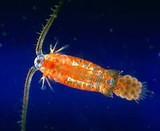

Copepods: Copepoda - Behavior And Reproduction
Free swimming copepods gather phytoplankton from the water by using their antennae and maxillipeds. The swimming movements of these appendages help to create a flow of food-carrying water toward their mouths.
Both male and female copepods are required for reproduction. Males locate females by following their pheromone trails in the water. Pheromones are chemicals that attract members of the same species. Males place a single sperm packet on the female's abdomen. The sperm escapes the packet, enters the female's body through the opening of her reproductive system, and is stored in special sacs. The fertilized eggs are usually carried in a pair of sacs attached to the abdomen.
The newly hatched Nauplius larva does not resemble the adult. Nauplius larvae do not feed and have only antennae and mouthparts for appendages. They use these appendages for swimming. The nauplius molts, or sheds its external skeleton (exoskeleton), six times before reaching a larval stage that resembles the adult. This stage must molt five times before reaching adulthood. In parasitic species, the development of the nauplius larva is much shorter, if it exists at all.
The second pair of cephalic appendages in free-living copepods is usually the main time-averaged source of propulsion, beating like oars to pull the animal through the water. However, different groups have different modes of feeding and locomotion, ranging from almost immotile for several minutes (e.g. some harpacticoid copepods) to intermittent motion (e.g., some cyclopoid copepods) and continuous displacements with some escape reactions (e.g. most calanoid copepods.)
Some copepods have extremely fast escape responses when a predator is sensed and can jump with high speed over a few millimetres. Many species have neurons surrounded by myelin (for increased conduction speed), which is very rare among invertebrates.
Despite their fast escape response, copepods are successfully hunted by slow-swimming seahorses, which approach their prey so gradually, it senses no turbulence, then suck the copepod into their snout too suddenly for the copepod to escape.
Finding a mate in the big wide open ocean of water is challenging. Some copepod females solve the problem by emitting pheromones, which leave a trail in the water that the male can follow.
Wikipedia.
animals.jrank.org/pages/1862/Copepods-Copepoda-BEHAVIOR-REPRODUCTION
